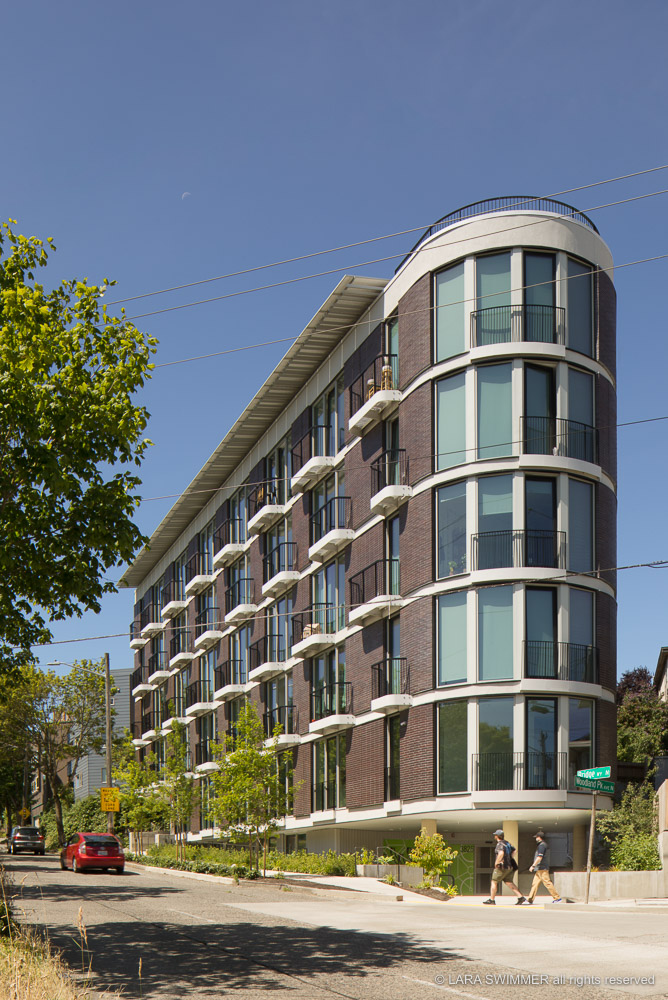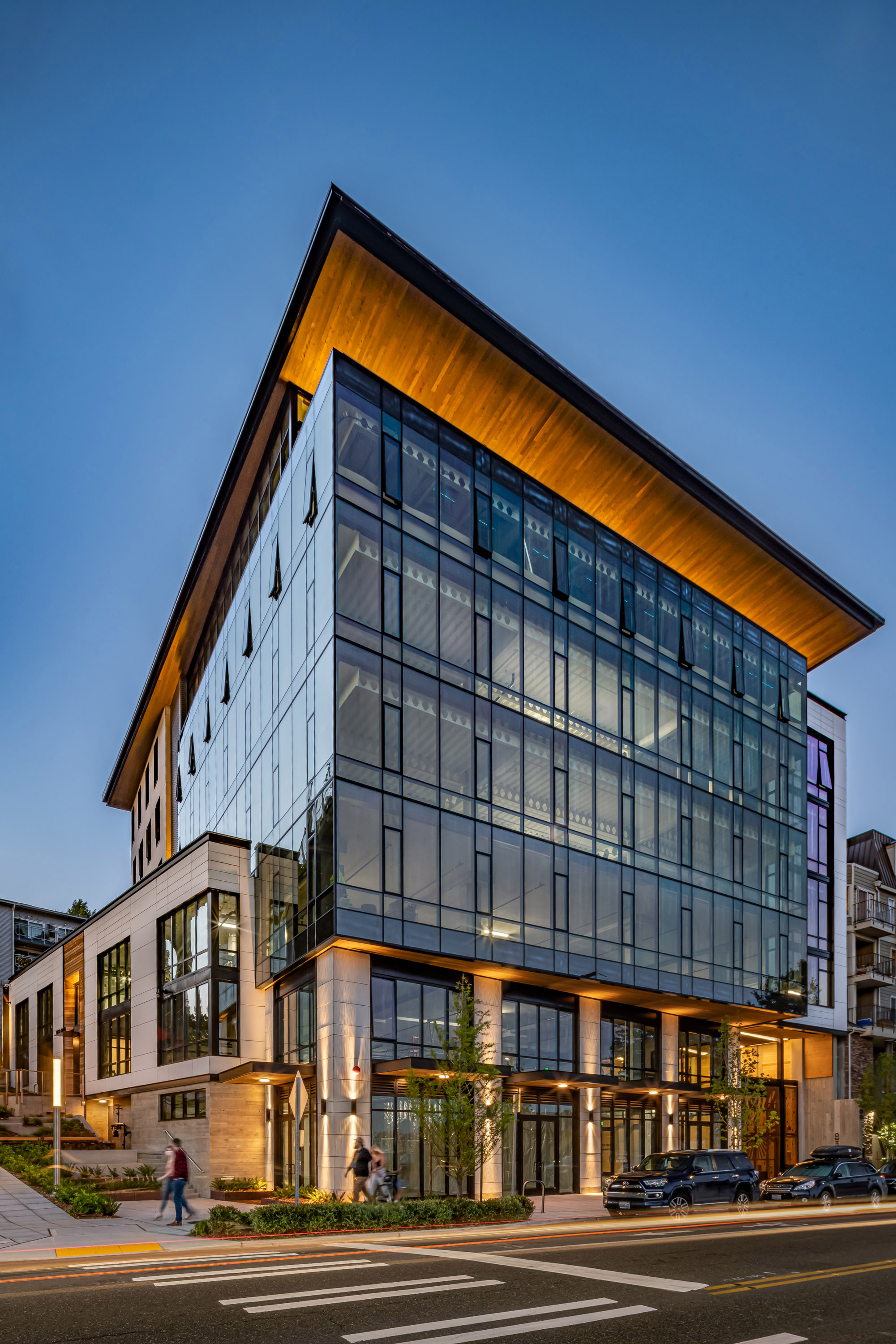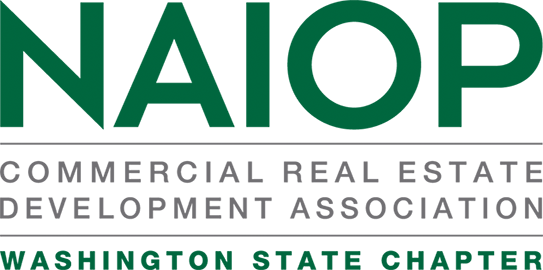NAIOP Washington Introduces Sustainability Award at Night of the Stars 2020
What does it mean to go first? In celebration of NAIOPWA’s Night of the Stars inaugural “Sustainable Development of the Year” category, here is a closer look at the two nominees, each of whom elected to be on the front edge of sustainable real estate development. Read below to learn more about these two industry-leading endeavors.
What is the first thing many developers or investors think when they hear the words “sustainable” or “green” as their architects describe their building design? For decades the common perception has been that it is difficult (if not impossible) to make a deeply green building pencil financially. However, by definition “sustainability” is the nexus of environmental, social and economic progress. We interviewed key participants representing both Watershed and Inspire at the Russell W. Young Building to learn how they overcame perception to create these very special properties.
Sustainable projects are an investment in our environment and our community, and they are also becoming more and more achievable. Watershed uses 25% less energy and 75% less water. Tenants are seeking out these types of developments. Inspire leased to 97% in the midst of Inslee’s “Stay Home, Stay Healthy” initiative. Jurisdictions are finding creative ways to incentivize sustainable development with things like greater FAR bonuses and additional building height. Sustainable projects are becoming normal and expected. These two projects highlight why.
A key take-away from both interviews was the depth to which all of the players have immersed themselves on a permanent path to demystifying sustainability. We appreciated their transparency and honesty, and we were humbled by their commitment. Inspire was “inspired” by the desire to create a family legacy here at home and by the Paris Agreement on climate action. Watershed is a continuation of the entire project team’s collaboration that began in 2008. Neither project is a “one-off,” and it is clear that was integral to their success.
Beyond the fact that it is probably no accident that both these projects are in Fremont, we will tease you with this: what if we told you that both the Inspire and Watershed projects are already meeting the projected ROI numbers in less than one year of operation?
 The Inspiration behind INSPIRE
The Inspiration behind INSPIRE
In mid-October members of the NAIOP Sustainability Committee sat down with Brett and Larry Phillips to explore the background behind their Living Building Challenge project, Inspire at the Russell W. Young Building, located in Seattle’s Fremont neighborhood.
Brett and Larry helped their family corporation develop the property and sought to create a building that was deeply green. During the project’s conception Brett and Larry had just returned from Paris where they were delegates to the Paris Agreement climate convention and knew that they wanted to implement its de-carbonization ambitions in our community as part of a family legacy. What better way to do this than to aim high and seek to develop a carbon-positive building using only private equity to demonstrate that it can be done and be profitable?
Once it was decided that a dense, urban, and affordable apartment project was in line with what the community needed, their next step was entering into the Living Building Pilot Program (LBPP) with the City of Seattle. The LBPP is a partnership between the International Living Future Institute (ILFI) and the City of Seattle. The current density incentives in that program, which allow for an additional floor of height or up to 25% more developable area, offset the extra costs inherent in developing to a Living Building standard. Inspire was completed under a previous version of the LBPP and only received a 15% increase in FAR.
The ILFI Energy Petal for carbon positive energy was a way to set a benchmark for multi-family projects in Seattle and the country, as we progress towards the 2030 Challenge. In fact, the building’s main feature is its solar energy array which extends over a majority of the roof and becomes an iconic beacon beckoning for others to follow suit. The solar energy system actually produces 105% of the building’s energy and as such, its residents do not have to pay electric bills, which helps residents save money or have more of their budget available to cover rent or other essentials.
When it comes to economics, Inspire also provides inspiration for developers considering the deep green route for their own developments. Its costs were reportedly 10-15% more than conventional construction but the project leased up quickly and has stabilized with a development yield north of 6%. And consider this--Inspire opened its doors in the spring of 2020, right when the world shut down due to the pandemic! That is a testament to the market demand for a well-executed and innovative sustainable building.
One of the biggest lessons they learned was around water usage. The City of Seattle part of the LBPP required using grey water for toilet flushing and irrigating. But they encountered hurdles with King County Public Health officials who were understandably focused on public health issues and who were simultaneously going through a plumbing code change. While the designed grey water treatment system did not get implemented, Inspire was still able to achieve 43% potable water savings beyond code requirements with advanced water reduction design and strategies. At the end of the day the project presented issues to these regulatory bodies that they had not yet encountered, and it will likely help inform how local governments think about and update codes in the future.
It was truly an inspiration to sit down with Brett and Larry and learn more about their experience with Inspire and how they took us one step closer to a sustainable, low-carbon future.
 WATERSHED: Community Impact at a Grand Scale
WATERSHED: Community Impact at a Grand Scale
In mid-October members of the NAIOP sustainability committee also sat down with Joanna Callahan, Kristen Scott and Myer Harrell to explore the background behind the Living Building Pilot Project (LBPP), Watershed, located in Seattle’s Fremont neighborhood.
Great projects always come with great partnership and Watershed is not an exception. The project is a collaboration between Hess Callahan, Mark Grey and Weber Thompson, architect and landscape architect of the project respectively. This partnership started a decade ago at the highly sustainable Terry Thomas Building, which was one of the first buildings in Seattle to achieve LEED Gold certification and remained fully occupied through the financial crisis. Since then, this partnership continued for Data One, Cedar Speedster (also a Night of the Stars 2020 finalist) and mostly recently Watershed. Watershed is the only building to pursue the 2014 version of Seattle’s Living Building Pilot Program and is pursuing the Materials, Place and Beauty Petal Recognition from the International Living Future Institute (ILFI).
What turned out to be an amazing surprise is how a simple decision to commit to clean water translated into an elegant design that has a major impact on cleaning millions of gallons of water that goes directly into salmon spawning waters. By looking beyond the boundaries of this property and cleaning water from the Aurora Bridge, Troll Avenue and an alley, Watershed has impacted an entire community and the environment in a lasting way. In addition, this Salmon Safe Certified project collects and reuses most of the water needed to flush the toilets from the roof. Watershed is truly water conservation at every level.
Project location is another important factor that contributes to the project success and a broader sustainability goal. Located in the heart of Fremont, surrounded by vibrant businesses and close to residential areas, this project contributes to the “15-minute neighborhood” concept. The adjacency to the Burke-Gilman Trail enables a true trail-oriented development. The project has 100 bike stalls with on-site shower facilities and only 14 parking stalls.
Deeply sustainable buildings do cost more, perhaps 10 – 15% more, but the lease rates at the higher end of market help with that. The current returns are comparable to any other successful commercial project. For this team of long term holders, the long term benefits of tenant retention and reduced operating costs are a definite financial advantage. Yet still the satisfaction of doing the right thing and creating a healthier building is a clear market differentiator. Companies are competing with the comfort of people’s homes to create environments where employees want to spend their time. And the “cool” factor doesn’t hurt either. Investors, tenants and occupants all are attracted to the reputational return on investment.
Watershed was completed under the third (2014) version of the Living Building Pilot and only received a 15% increase in FAR which proved to be an insufficient incentive. The current version of the program boosts that to 25% increase in Floor Area Ratio, but simultaneously increases the requirements. Watershed has a 20,000 gallon cistern that collects a minimum of 50% of the roof storm water to be used for toilet flushing and irrigation. The current version requires rainwater collection for all non-potable uses year-round. This results in as much as ten times the amount of water storage capacity on site. Energy reduction stays at 25%; however, the new 2018 Energy Code will make hitting that target more difficult.
From the policy standpoint, the team appreciates the City having the LBPP program to encourage deep green buildings, but also would like to see more incentives because of the expanded benefits a project like this could bring to the community. At the same time, it would be easier to obtain a more diverse tenant pool if the program could modify the requirements for tenant improvements and only require core and shell compliance.
One piece of advice that project team member Joanna gave to everyone when we asked her what should we do to further the conversation of sustainable development: employees signaling the need for sustainable features to their employer or landlord would give owners and developers increased confidence to go the extra mile of achieving higher sustainability measures and developing more sustainable projects.
This blog was written by members of NAIOPWA's Sustainable Development Committee, including Matt Elley (AMLI), Heather Bunn (RAFN Company), Tim Zielke (MG2), Lanzi Li (Heartland LLC), Rachael Meyer (Weber Thompson), and Angela Tomlinson (Rushing Company).
